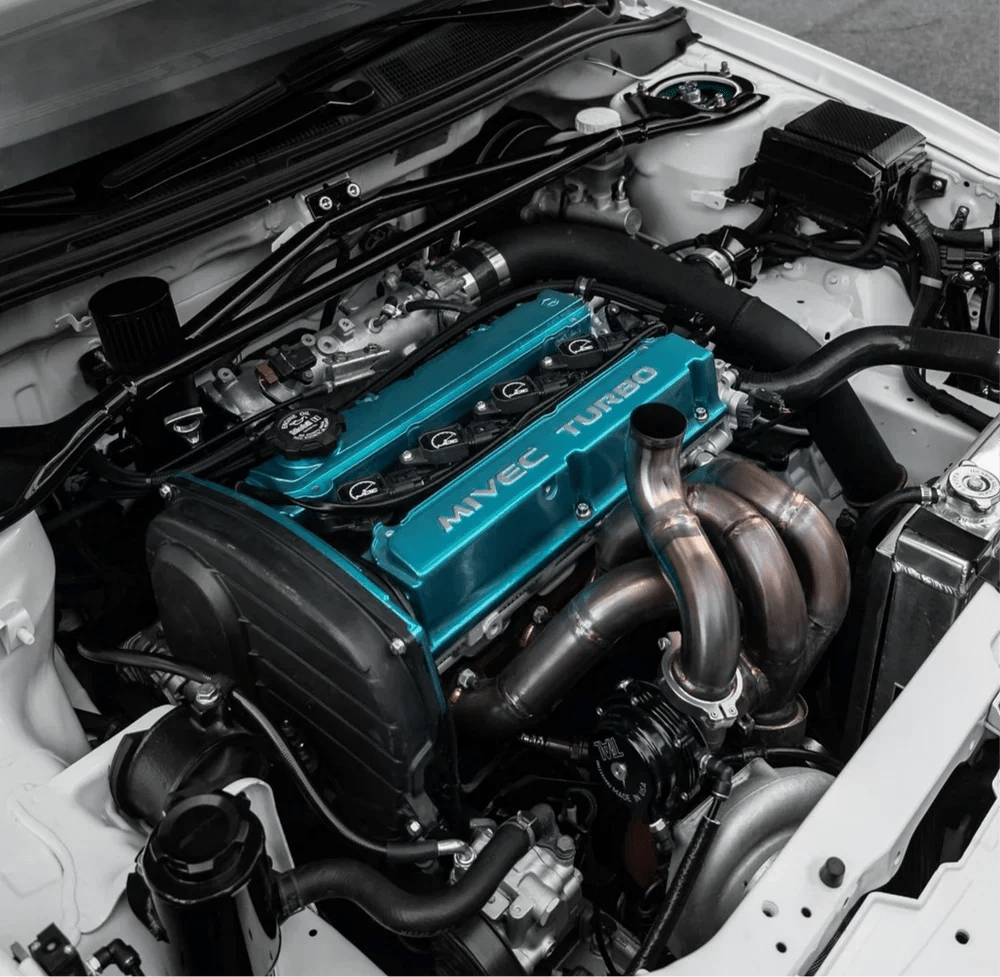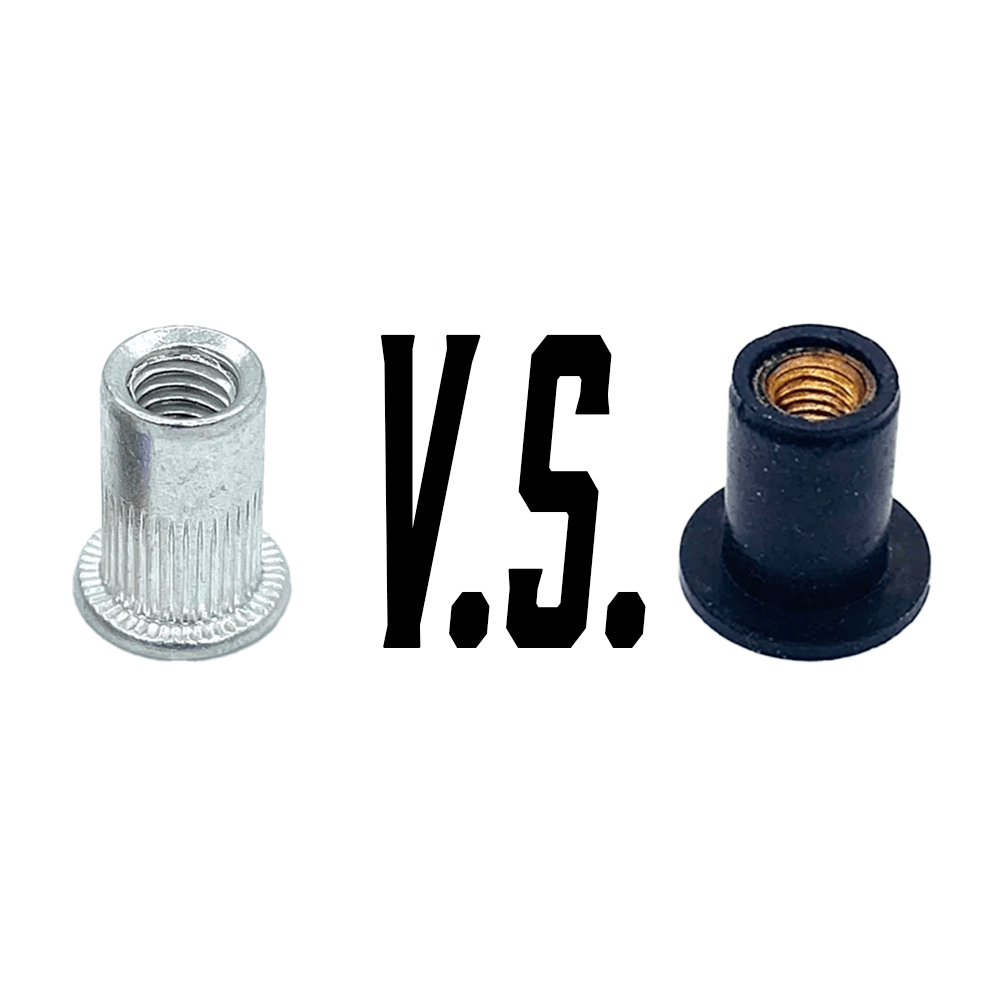Why Your Ignition System Matters
The ignition system is essential for maximizing the performance, efficiency, and reliability of a 4G63-powered vehicle. Whether increasing horsepower, refining throttle response, or maintaining smooth daily operation, a strong ignition setup ensures consistent spark, efficient fuel burn, and optimal combustion. A weak or aging system can cause misfires, power loss, and reduced fuel efficiency, limiting the engine’s potential.
What Does an Ignition System Do, and Why is it Important?
A strong ignition system is the unsung hero of any 4G63 build—firing off the spark that keeps power flowing, throttle response crisp, and reliability rock solid. Whether you’re chasing big horsepower, fine-tuning your street setup, or just making sure your Evo or DSM doesn’t sputter at the worst possible moment, ignition performance makes or breaks your engine’s potential.
A weak system? That’s a recipe for misfires, power loss, and sluggish response—the last things you want when you're pushing boost. But a properly dialed-in ignition setup delivers consistent spark, clean combustion, and maximum efficiency, keeping your build running at its absolute best.
A strong ignition system improves:
-
Power Output – A more complete burn ensures maximum energy conversion from fuel to power.
-
Throttle Response – A consistent, high-energy spark leads to sharper acceleration.
-
Fuel Efficiency – Better combustion reduces unburned fuel and wasted energy.
-
Reliability – Prevents misfires, hesitation, and rough idle, making the engine run smoother.
For performance-oriented 4G63 owners, upgrading the ignition system can mean the difference between stable, repeatable power and an engine that struggles under boost or high RPM.
Understanding the Stock 4G63 Ignition System: Strengths & Limitations
The Mitsubishi 4G63 engine, found in the Evolution 4-9 and DSM models (Eclipse, Talon, Laser), comes from the factory with a waste-spark ignition system. This setup consists of:
-
Two ignition coils (each responsible for firing two cylinders).
-
Spark plug wires that connect the coils to the spark plugs.
-
Ignition module (power transistor unit) that controls spark timing.
The 4G63’s waste-spark ignition system fires each coil twice per engine cycle—once for combustion and once as a throwaway spark. While this design is cost-effective and reliable, it starts to show its weaknesses as boost and power levels increase.
Higher boost creates higher cylinder pressure, making it harder for the spark to ignite the air-fuel mixture. Since the stock system shares coils and relies on plug wires, it can struggle to maintain spark strength under these conditions. The result? Misfires, inconsistent combustion, and power loss, especially at high boost or high RPM.
For stock and mildly modified setups, the OEM ignition is usually enough. But if you’re pushing beyond factory limits, a stronger, more efficient ignition system becomes a must. Next, we’ll break down the pros and cons of different ignition setups to help you decide when it’s time to upgrade.
When the Stock Ignition System is Sufficient—And When It’s Not
The factory ignition system on the 4G63 engine was designed to be reliable, cost-effective, and efficient within the constraints of factory power levels. However, as modifications increase horsepower and boost pressure, the system begins to show its limitations. Understanding both the strengths and weaknesses of the stock ignition setup is crucial when deciding whether an upgrade is necessary.
Strengths of the Stock 4G63 Ignition System
1. Simple & Reliable at Stock Power Levels
The waste-spark ignition system in the 4G63 is a tried-and-true design that works well for stock or lightly modified setups. It provides adequate spark energy for normal driving and mild performance upgrades.
2. Cost-Effective & Easy to Diagnose Issues
With only two coil packs and a simple ignition module, diagnosing and replacing components is straightforward. If a misfire occurs, troubleshooting is relatively simple compared to more complex coil-on-plug (COP) or distributor-based systems.
3. Sufficient for Mild Modifications
For builds running stock turbo pressure or moderate boost increases, the factory ignition system generally holds up without major issues. Basic bolt-on upgrades such as intake, exhaust, and minor tuning can be supported by the stock coils and ignition module without immediate need for an upgrade.
Why Waste-Spark Coils and Plug Wires Can’t Handle High Boost
1. Coils Fire Twice as Often, Reducing Efficiency at High RPM
Because the waste-spark system fires each coil twice per engine cycle, the coils operate at twice the workload of an individual coil setup. As RPM increases, the available charge time (dwell time) decreases, reducing spark energy and efficiency. This becomes a limiting factor for high-revving or high-boost applications.
2. Plug Wires Introduce Resistance, Reducing Spark Energy
Unlike coil-on-plug (COP) systems, which send power directly to the spark plugs, the stock ignition relies on spark plug wires to transmit voltage from the coil to the plug. Over time, these wires degrade, increasing electrical resistance and reducing spark intensity. This can lead to weak ignition, misfires, and inconsistent combustion—especially in older engines.
3. Higher Chance of Misfire & Spark Blowout Under High Boost
As boost pressure increases, cylinder pressure rises, making it harder for the spark to ignite the air-fuel mixture. The factory coils may struggle to generate sufficient spark energy, leading to misfires or weak combustion under load. This phenomenon, known as spark blowout, is a common issue on high-boost 4G63 builds and can result in power loss, rough running, and reduced efficiency.
If you’re experiencing any of these issues, it may be time to consider an ignition system upgrade.
Signs Your Ignition System Needs an Upgrade
Even at stock or mildly modified power levels, ignition components degrade over time. If you’re experiencing any of the following performance issues, it could indicate that your ignition system is struggling to keep up.
1. Misfires Under Boost or High RPM
One of the most common signs of a weak ignition system is misfires under acceleration, high RPM, or increased boost levels. This occurs when the spark isn’t strong enough to ignite the fuel-air mixture completely, leading to hesitation, stuttering, or power loss.
2. Inconsistent Power or Throttle Response
A failing ignition system can cause uneven power delivery, sluggish acceleration, or delayed throttle response. If the engine feels unpredictable—strong one moment and weak the next—inconsistent spark timing or weak ignition energy could be the culprit.
3. Check Engine Lights Related to Ignition Faults
If your Evo or DSM throws a check engine light (CEL) for misfire codes (P0300-P0304), this is a strong indicator that your ignition system is failing. While issues such as fueling problems or mechanical failures can also trigger misfire codes, ignition-related CELs often stem from worn coils, failing plug wires, or weak spark output.
4. Uneven Spark Plug Wear or Excessive Fouling
Spark plugs can reveal a lot about ignition health. If your plugs show uneven wear, carbon buildup, or are fouling prematurely, this suggests that the ignition system isn’t burning fuel efficiently. Running colder plugs with insufficient spark energy can lead to excessive fouling, further reducing performance.
What’s Next?
If you’re experiencing any of these issues, it may be time to explore ignition system upgrades. In the next section, we’ll compare the available options—including OEM replacements, aftermarket coils, CDI systems, and Coil-On-Plug (COP) setups—to help you determine the best solution for your 4G63.
Ignition System Upgrade Options: What’s Best for Your Setup?
Upgrading the 4G63 ignition system isn’t a one-size-fits-all decision. Whether you're aiming for reliable daily performance or high-boost domination, your choice depends on power goals, budget, and long-term build plans. From OEM replacements to full-on high-performance setups, each option has its pros and cons. Let’s break down the most common upgrades and when they make the most sense for your build.
OEM Replacement Coil Packs: When a Simple Swap is Enough
When is a Simple Replacement Enough?
For owners who want to restore lost performance due to aging components but aren’t pushing their engines beyond factory power levels, replacing the stock ignition coils with OEM-style replacements is often sufficient.
If your Evo or DSM is mostly stock or only lightly modified, fresh OEM or OE-spec coils will typically restore smooth operation without the need for more advanced upgrades.
Pros of Staying with the Factory-Style System:
-
Cost-Effective: Generally the cheapest option, with OEM-quality replacements available.
-
Simple Installation: Direct plug-and-play with no tuning or additional wiring required.
-
Reliable for Stock to Mildly Modified Setups: Works well for engines making under 400 WHP with minor bolt-ons.
Cons of Staying with the Factory-Style System:
-
Limited High-RPM & Boost Capability: Still prone to spark blowout at higher cylinder pressures.
-
Still Uses Waste-Spark Design: Coils fire twice as often, reducing efficiency at high RPM.
-
Retains Plug Wires: Potential for voltage loss, increased resistance, and eventual wire degradation.
Who Should Choose This?
-
Stock or lightly modified Evos/DSMs running factory boost or small increases.
-
Owners who want a quick fix for a failing ignition system without additional modifications.
-
Those who don’t plan on pushing power beyond 400 WHP.
If you’re planning to run higher boost, more aggressive tuning, or larger turbo setups, an aftermarket ignition upgrade is a smarter long-term solution.
Performance Coil Packs: Do You Need Stronger Coils?
For those looking to improve spark energy while maintaining the factory-style system, aftermarket high-performance coil packs (such as NGK, AEM, or MSD) are an option. These stronger coils deliver higher voltage output, allowing for better combustion efficiency and resistance to spark blowout.
Can Upgraded Coil Packs Fix Ignition Weaknesses?
-
Higher Voltage Output: Delivers a stronger spark for more reliable combustion.
-
Better Performance at Moderate Boost Levels: Reduces the chances of misfires without requiring major rewiring.
-
Direct Plug-and-Play Fitment: No modifications or tuning required.
Why Performance Coils Still Have Limitations at High Boost
Still Uses the Waste-Spark System: These coils still fire twice as often, meaning increased wear and reduced efficiency at high RPM.
Relies on Plug Wires: Spark energy can still be lost due to wire resistance, aging, and heat-related degradation.
Limited Power Potential: While better than OEM, high-performance coils still struggle beyond 450-500 WHP under high boost.
Who Should Choose This?
-
Owners looking for a mild ignition upgrade while keeping factory-style components.
-
Builds that stay below 450 WHP with stock-like reliability.
-
Those who want an easy bolt-on solution without additional tuning.
While an improvement over OEM, aftermarket coil packs do not fully eliminate the limitations of the stock ignition system. For higher boost applications, more advanced solutions are required.
CDI Ignition Systems: Are They Worth It for the 4G63?
How CDI Ignition Works & When It’s Necessary
A CDI (Capacitive Discharge Ignition) system works by storing energy in a capacitor and releasing it in a high-voltage pulse to the coils. This creates a stronger, faster spark that improves ignition efficiency, especially at high RPM.
CDI systems, such as the MSD DIS-2, are often used in racing applications where higher cylinder pressures require more powerful ignition energy.
Pros of CDI Ignition for the 4G63:
-
Higher Spark Voltage: Provides a much stronger and faster spark than stock ignition systems.
-
Multi-Spark Discharge at Low RPM: Can fire multiple sparks per cycle at lower RPM for improved combustion.
-
Useful for Drag & High-Boost Applications: Helps prevent spark blowout in extreme power builds.
Cons of CDI Ignition for the 4G63:
-
Complex Installation: Requires additional wiring and is not a plug-and-play upgrade.
-
Expensive: CDI systems cost significantly more than high-performance coil packs or COP kits.
-
Not Ideal for Street Builds: While beneficial for drag racing or extreme setups, CDI doesn’t offer noticeable gains for moderate power levels.
Who Should Choose This?
-
High-horsepower drag racing builds running 40+ PSI of boost.
-
Dedicated race cars that need ultra-high energy spark for methanol or nitrous setups.
-
Builders who don’t mind the extra wiring and tuning requirements.
For most street or track builds, a COP system provides similar benefits without the added complexity of a CDI system.
Coil-On-Plug (COP) Systems: The Best Ignition Upgrade for 4G63?
The most cost effective ignition upgrade for the 4G63 is switching to a Coil-On-Plug (COP) system. Instead of using two coil packs and spark plug wires, a COP system places an individual coil directly on each spark plug, eliminating the inefficiencies of the waste-spark system.
How COP Systems Eliminate Plug Wires & Improve Spark Energy
-
Each cylinder has its own dedicated coil, allowing for a stronger, more consistent spark.
-
No more spark plug wires, meaning zero energy loss from wire resistance.
-
Improved spark energy & combustion stability, especially at high boost and RPM.
The Benefits of Individual Coil Per Cylinder Setups
-
Eliminates Spark Blowout: Delivers stronger spark energy directly to the plug, preventing misfires.
-
More Efficient Power Delivery: Each coil only fires once per cycle, reducing heat and extending coil life.
-
Better Throttle Response & Fuel Efficiency: More complete combustion leads to cleaner, more efficient power.
-
Perfect for High-Boost & High-Revving Builds: Proven to handle 600+ WHP without ignition issues.
-
Plug-and-Play Installation: Many COP kits are direct bolt-on replacements for the stock ignition system.
Who Should Upgrade to a COP System?
-
Anyone pushing beyond 400-450 WHP who wants a reliable, high-performance ignition solution.
-
Owners tired of dealing with plug wires, misfires, or inconsistent spark delivery.
-
Those looking for a cleaner engine bay and simplified ignition system.
While high-performance coil packs and CDI systems offer some benefits, a COP system provides the best balance of performance, reliability, and ease of installation.
How to Choose the Best Coil-On-Plug System for Your 4G63
The stock waste-spark system and plug wires introduce inefficiencies that can hold back performance, especially under high boost. A Coil-On-Plug (COP) system is the best long-term solution for stronger, more reliable spark delivery, but not all COP kits are built to the same standard. A well-designed system will eliminate ignition issues, while a poorly made one can cause more problems than it solves.
In this section, we’ll cover what to look for in a quality COP kit, compare available options, and explain why JDC’s COP system stands out as one of the best choices for 4G63 owners.
Features to Look for in a COP Kit
A high-quality COP system should do more than just eliminate spark plug wires—it should improve overall spark energy, reliability, and long-term performance. Here are the essential factors to consider when selecting the right kit for your build:
1. High-Quality Ignition Coils
The ignition coils are the heart of the system. Many cheap COP kits use low-quality or repurposed coils, leading to weak spark output, misfires, or early failure. Look for a system that uses:
-
Authentic, high-performance coils (such as Denso or Hitachi).
-
Proven compatibility with the 4G63 engine’s dwell settings and ECU requirements.
-
Reliable performance under high boost and RPM without voltage drop.
2. Secure Mounting System
A well-designed mounting plate ensures the coils are positioned correctly over the spark plugs, preventing poor contact, loose connections, or excessive engine vibration. A CNC-machined plate made from durable materials like billet aluminum is preferred over thin, stamped metal plates that flex under heat and stress.
3. Reliable Wiring Harness & Compatibility
A plug-and-play harness eliminates the need for splicing or modifying factory wiring, ensuring a clean installation. Important features to look for:
-
Military-spec wire sheathing to withstand high engine bay temperatures.
-
Proper grounding and waterproof connectors to prevent electrical issues.
-
Compatibility with stock ECU and standalone systems (AEM EMS, Haltech, MegaSquirt, etc.).
4. Compatibility with Engine Bay Components
Some COP kits do not fit under stock or aftermarket spark plug covers, leaving coils exposed to dirt, debris, and heat. A well-designed kit should:
-
Fit under the factory spark plug cover for protection.
-
Work with both OEM and aftermarket valve covers.
5. Proven Performance & Reliability
A good COP system should be tested to handle high horsepower, boost levels, and track conditions. Look for customer reviews, dyno results, and real-world testing before making a purchase.
Comparing Popular COP Kits: Which One is Best?
With multiple brands offering Coil-On-Plug solutions for the 4G63, it’s important to understand the differences between high-quality kits and lower-end alternatives.
|
Feature |
JDC COP System |
Generic COP Kits |
OEM-Coil Conversion Kits |
|
Ignition Coils |
Authentic Denso or Hitachi (high-output, proven to 900+ WHP) |
Cheap aftermarket or used coils (low reliability) |
Uses repurposed coils from other vehicles |
|
Mounting Plate |
CNC-machined billet aluminum (precision fit) |
Thin, stamped metal (flexes under heat) |
Often requires modifications |
|
Wiring Harness |
Pre-wired, plug-and-play (military-spec wiring) |
May require splicing or custom wiring |
Requires custom adapter harness |
|
Performance Under Boost |
Tested up to 913 WHP with no spark blowout |
Inconsistent performance at high RPM/boost |
Limited to stock-like performance |
|
Ease of Installation |
True plug-and-play (no cutting required) |
May require modifications |
Requires additional wiring & tuning |
|
Warranty |
2-3 years on coils, lifetime on wiring & mounting plate |
Limited or no warranty |
No warranty on repurposed coils |
What Makes a High-Quality COP System Stand Out?
-
Reliable, high-performance coils built for high-horsepower setups.
-
A mounting plate that won’t flex or warp under heat.
-
Plug-and-play wiring with high-temperature protection.
-
Tested in real-world high-boost applications.
Why JDC’s Coil-On-Plug System is the Best Option for 4G63 Owners
The JDC Coil-On-Plug (COP) Ignition System was designed specifically for Mitsubishi 4G63 engines, offering a trouble-free installation, premium materials, and proven performance under high boost.
Key Features That Set JDC’s COP System Apart
High-Output Ignition Coils (Denso or Hitachi)
-
Authentic Japanese-made ignition coils for maximum reliability and spark energy.
-
Tested up to 913 WHP @ 0.020” spark plug gap with no misfires or spark blowout.
-
No tuning required when using Denso coils (Hitachi coils require dwell time adjustments).
CNC-Machined Mounting Plate for a Perfect Fit
-
Billet aluminum construction ensures durability under extreme temperatures.
-
Precision-machined for exact coil placement, preventing misalignment or poor spark contact.
-
Fits under OEM and most aftermarket spark plug covers.
Pre-Wired, Plug-and-Play Installation
-
Military-spec wiring & Tefzel sheathing rated for high heat and extreme conditions.
-
No splicing, cutting, or modifying factory wiring—100% bolt-on.
-
Waterproof connectors and heat-resistant components for long-term reliability.
Boost-Ready Performance
-
Eliminates spark blowout at high boost/RPM.
-
Allows for a larger spark plug gap, improving combustion efficiency and throttle response.
-
Greatly reduces or eliminates partial throttle bucking.
Optional "Hideaway" Harness for a Cleaner Engine Bay
-
Routes wiring discreetly behind the valve cover, eliminating exposed wires for a stealth look.
-
Removes unnecessary clutter for a clean, wire-tucked appearance.
Proven Track Record & Warranty Support
JDC’s COP system has been trusted since 2015 by performance shops and tuners worldwide.
Backed by a strong warranty:
-
Refurbished Denso Coils: 2-year warranty.
-
New Denso Coils & Hitachi Coils: 3-year warranty.
-
Wire Harness & Mounting Plate: Lifetime warranty.
Why Choose JDC’s COP System Over Other Options?
If you’re serious about maximizing ignition performance, improving reliability, and future-proofing your 4G63, the JDC Coil-On-Plug Ignition System is the best option on the market.
Why JDC is the Best Choice:
-
Proven to eliminate spark blowout under high boost (tested up to 913 WHP).
-
Uses authentic Denso or Hitachi coils (not cheap knock-offs).
-
CNC-machined billet aluminum mounting plate for a secure fit.
-
Pre-wired, plug-and-play harness with military-spec wiring.
-
Compatible with stock ECUs & standalone systems (AEM, Haltech, etc.).
-
Backed by industry-leading warranties for long-term reliability.
If you’re tired of misfires, weak spark, or unreliable ignition, upgrading to a JDC COP system is one of the best performance investments you can make for your Evo or DSM.
Installation & Tuning: How to Get the Most from Your COP System
Upgrading to a Coil-On-Plug (COP) Ignition System is one of the best ways to improve ignition performance and reliability in the 4G63 engine. While COP kits are generally plug-and-play, proper installation and tuning considerations will ensure you get the most out of your upgrade.
This section provides a step-by-step installation guide, spark plug recommendations, and tuning adjustments to maximize performance.
How to Install a Coil-On-Plug System on Your 4G63
Step-by-Step Installation Guide (Tools, Prep, and Setup)
Before starting the installation, make sure you have the necessary tools and materials:
Tools Needed:
-
10mm socket & ratchet (for coil mounting bolts).
-
Hex key or Allen wrench set (for securing the mounting plate).
-
Torque wrench (to avoid overtightening).
-
Dielectric grease (to prevent corrosion in coil boots).
-
Anti-seize compound (for spark plug installation).
Pre-Installation Checklist:
-
Ensure the engine is cool before working.
-
Disconnect the negative battery terminal to avoid electrical shorts.
-
Remove the OEM ignition system, including coils and plug wires.
Mounting the Coils & Connecting the Harness
Step 1: Remove the Factory Coils & Wiring
-
Unbolt and remove the OEM ignition coils from the valve cover.
-
Disconnect the gray connectors from each side of the harness.
-
Remove the plug wires and inspect the spark plug wells for debris.
Step 2: Install the JDC Coil-On-Plug System
-
Place the JDC mounting plate over the valve cover, ensuring it aligns with the coil positions.
-
Insert each ignition coil into the spark plug wells, pressing firmly to seat them properly.
-
Secure the mounting plate using the provided hex head bolts & washers.
-
Do not overtighten—this could strip the valve cover threads.
Step 3: Connect the Wiring Harness
-
Plug in the COP harness connectors to each ignition coil.
-
Connect the left-side and right-side harness leads to the factory coil connectors.
-
If using the JDC Hideaway Harness, route the wiring discreetly behind the thermostat housing for a clean, tucked look.
Step 4: Replace the Factory Fuse with the Provided 15A Fuse
-
Locate the fuse box inside the car, near the driver-side floorboard.
-
Replace the 10A ignition fuse with the provided 15A fuse (position #1 in the fuse box).
Step 5: Final Inspection & Start-Up Check
-
Ensure all connectors are securely fastened—loose connections can cause misfires.
-
Check for clearance issues with aftermarket valve covers or spark plug covers.
-
Reconnect the battery and start the car.
-
If the engine idles smoothly and there are no misfires, the installation is successful!
-
If you experience rough idle or misfires, check for loose connections, grounding issues, or faulty coils.
Spark Plug Selection & Gap Settings for Best Performance
Choosing the right spark plugs and setting the correct gap is crucial to prevent misfires, spark blowout, and ignition inefficiencies.
The Best Spark Plugs for Stock, Street, and High-Boost Builds
|
Build Type |
Recommended Spark Plug |
Heat Range |
Gap Setting |
|
Stock & Bolt-On Builds (Under 400 WHP) |
NGK BPR7ES |
7 |
0.028" - 0.030" |
|
Mild Performance (400-500 WHP, Pump Gas) |
NGK BR8ES |
8 |
0.024" - 0.026" |
|
High-Boost Setup (500-700 WHP, E85 or Race Gas) |
NGK BR9ES |
9 |
0.018" - 0.022" |
|
Extreme Builds (700+ WHP, High-Boost Drag Setup) |
NGK R5671A-10 |
10 |
0.014" - 0.018" |
Why Spark Plug Gapping Matters
-
A larger spark plug gap allows for a stronger spark and better fuel burn but can lead to blowout under high boost.
-
A smaller gap reduces blowout risk but may cause incomplete combustion if too tight.
-
COP systems allow for a slightly larger gap compared to OEM coils due to the stronger ignition energy.
For JDC COP Systems:
-
Denso Coils: Run 0.020" - 0.022" for high-boost applications.
-
Hitachi Coils: Can handle 0.018" - 0.024" but require proper dwell tuning (see next section).
ECU Adjustments & Tuning Considerations
While JDC’s Denso-based COP system is plug-and-play with the stock ECU, some setups—especially those using Hitachi (GT-R) coils—may require adjustments to ignition dwell settings for optimal performance.
When Tuning is Necessary After Installing a COP System
-
If switching from stock coils to Hitachi coils (GT-R ignition dwell requires adjustments).
-
If experiencing misfires or weak spark under load (adjust dwell time).
-
If tuning for a standalone ECU (AEM, Haltech, MegaSquirt, etc.).
Setting the Correct Dwell Time for Hitachi Coils
Unlike Denso coils, Hitachi coils require specific dwell settings to maximize spark energy without overheating.
|
Voltage |
Recommended Dwell Time (ms) |
Max Safe Dwell Time (ms) |
|
14V (Standard Charging) |
3.4ms |
4.5ms |
|
Under Heavy Load (High Boost) |
3.6ms |
4.5ms |
|
Max High-Performance Tuning |
4.0ms |
5.0ms |
|
Unsafe Overload Risk |
5.5ms+ |
Risk of coil failure |
Warning:
Exceeding 5.5ms at 14V can lead to coil oversaturation and premature failure.
Fine-Tuning Ignition Timing for Maximum Performance
-
Too much timing advance can cause detonation (knock) under boost.
-
Too little timing results in sluggish performance and excessive exhaust heat.
-
A professional tuner should adjust ignition timing based on fuel type, boost pressure, and engine modifications.
Recommended Dwell & Spark Plug Gap Settings for Different Setups
|
Power Level |
Recommended Dwell (Hitachi Coils) |
Spark Plug Gap |
|
Mild Street Setup (Under 450 WHP) |
3.4ms @ 14V |
0.022" - 0.024" |
|
High-Boost Street/Track (450-600 WHP) |
3.6ms @ 14V |
0.018" - 0.022" |
|
Extreme Power (600+ WHP, E85) |
4.0ms @ 14V |
0.014" - 0.018" |
Final Thoughts on Installation & Tuning
Installing a COP system correctly and fine-tuning spark plug gaps and dwell settings ensures optimal performance, reliability, and longevity.
-
If running JDC’s Denso-based COP system, no tuning is required—it’s fully plug-and-play.
-
If running Hitachi coils, fine-tuning dwell time and spark plug gaps will maximize ignition performance.
-
For extreme builds, working with a tuner is highly recommended to dial in ignition timing.
Next Steps: Testing & Performance Benefits
With your COP system installed and tuned, you’re ready to experience:
-
Stronger, more consistent spark at high RPM.
-
Elimination of misfires and spark blowout under boost.
-
Improved throttle response and cold start reliability.
In the next section, we’ll wrap up with real-world performance benefits, and final recommendations
Should You Upgrade? The Long-Term Benefits of a COP System
Upgrading the ignition system is often overlooked in performance builds, but for 4G63 owners pushing higher boost levels or demanding maximum reliability, a Coil-On-Plug (COP) system is one of the best investments for overall engine performance.
If you've experienced misfires, inconsistent power, or spark blowout, switching to a COP system will eliminate these issues while improving throttle response, combustion efficiency, and overall reliability. But is it the right choice for every build?
How a COP System Future-Proofs Your Build
-
Eliminates Spark Blowout & Misfires – No more ignition break-up at high RPM or boost.
-
More Efficient Spark Energy Delivery – Each cylinder gets its own dedicated coil, ensuring stronger combustion.
-
No More Plug Wires – Removes resistance losses from degrading wires.
-
Better Cold Starts & Idle Stability – Especially beneficial for E85 users.
-
Improved Fuel Efficiency & Power Output – More complete combustion leads to better fuel burn.
-
Easier Spark Plug Maintenance – No wires to deal with, making plug changes faster and easier.
Who Should Upgrade?
-
Street Performance Builds (300-500 WHP) – A COP system ensures smooth ignition without requiring additional tuning (Denso coils).
-
High-Boost & Track Builds (500+ WHP) – Eliminates spark issues that stock-style ignition systems struggle with.
-
E85 & Race Fuel Users – More consistent spark improves cold starts and combustion efficiency.
-
Anyone Experiencing Misfires Under Boost – If you've already tried adjusting spark plug gaps and dwell times without success, a COP system is the solution.
What Are the Best Alternatives to a COP System?
If a full COP system upgrade isn’t in the budget or your build doesn't require the added ignition performance, here are some alternatives:
1. OEM Replacement Coils & Plug Wires
-
Best for stock or lightly modified cars that aren’t exceeding 400 WHP.
-
Simple and cost-effective, but still prone to misfires at high boost levels.
2. Aftermarket Performance Coil Packs (NGK, AEM, etc.)
-
Higher voltage than stock coils, helping reduce misfires.
-
Still retains waste-spark inefficiencies and plug wires, meaning spark energy is not as optimized as a COP setup.
3. CDI Ignition Systems (MSD DIS-2, etc.)
-
Provides stronger spark at high RPM and supports aggressive timing adjustments.
-
Expensive and requires additional wiring modifications.
-
More beneficial for extreme drag racing builds than street-driven setups.
Which Alternative Makes Sense?
-
If you are under 400 WHP and just need a refresh, OEM or aftermarket coil packs will work.
-
If you plan to push higher power later, a COP system is the smarter long-term investment.
-
CDI is not necessary for most builds unless you're racing at extremely high power levels.
Why a Properly Upgraded Ignition System Improves Overall Performance
A weak ignition system can rob power, hurt efficiency, and cause tuning headaches. An upgraded ignition system—especially a COP system—solves these issues and ensures the engine runs smoothly under all conditions.
Performance Gains from an Upgraded Ignition System:
Stronger, more consistent spark → No hesitation or break-up under boost.
More complete fuel burn → More power & improved fuel efficiency.
Lower risk of misfires → Smoother operation and reliable power delivery.
Reduced maintenance → No plug wires to replace, coils last longer.
Final Verdict: Is a COP System the Best Choice for Your 4G63?
If you’re running moderate to high boost, E85, or pushing past 400 WHP, the stock ignition system will eventually become a limitation. A Coil-On-Plug system eliminates the weaknesses of plug wires and wasted-spark ignition, ensuring strong, reliable spark delivery under all conditions.
For 4G63 enthusiasts looking for the best balance of power, reliability, and long-term performance, a properly designed COP system is the best solution.







Share:
EVO 8とEVO 9の類似点と相違点
How Do You Make Your WRX/STI Handle Better?